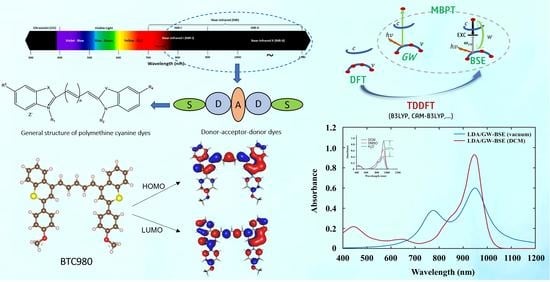Optical and Electronic Properties of Organic NIR-II Fluorophores by Time-Dependent Density Functional Theory and Many-Body Perturbation Theory: GW-BSE Approaches
Abstract
:1. Introduction
2. Computational Methods
2.1. GW-BSE Calculations
2.2. TDDFT Calculations
3. Results and Discussion
3.1. Optical Property
3.2. Solvation Effect
3.3. Electronic Property
4. Conclusions
Supplementary Materials
Author Contributions
Funding
Conflicts of Interest
References
- Baldo, M.A.; Thompson, M.E.; Forrest, S.R. High-efficiency fluorescent organic light-emitting devices using a phosphorescent sensitizer. Nature 2000, 403, 750–753. [Google Scholar] [CrossRef]
- Resch-Genger, U.; Grabolle, M.; Cavaliere-Jaricot, S.; Nitschke, R.; Nann, T. Quantum dots versus organic dyes as fluorescent labels. Nat. Methods 2008, 5, 763–775. [Google Scholar] [CrossRef]
- Avnir, D.; Kaufman, V.R.; Reisfeld, R. Organic fluorescent dyes trapped in silica and silica-titania thin films by the sol-gel method. Photophysical, film and cage properties. J. Non-Cryst. Solids 1985, 74, 395–406. [Google Scholar] [CrossRef]
- Speas, W.E. A quantitative study of the changes produced in the absorption bands of certain organic fluorescent dye solutions by alterations of concentration and temperature. Phys. Rev. 1928, 31, 569. [Google Scholar] [CrossRef]
- Schiedel, M.S.; Briehn, C.A.; Bäuerle, P. Single-compound libraries of organic materials: Parallel synthesis and screening of fluorescent dyes. Angew. Chem. Int. Ed. 2001, 40, 4677–4680. [Google Scholar] [CrossRef]
- Bai, G.; Li, J.; Li, D.; Dong, C.; Han, X.; Lin, P. Synthesis and spectrum characteristic of four new organic fluorescent dyes of pyrazoline compounds. Dye. Pigment. 2007, 75, 93–98. [Google Scholar] [CrossRef]
- Pu, Y.-J.; Higashidate, M.; Nakayama, K.-i.; Kido, J. Solution-processable organic fluorescent dyes for multicolor emission in organic light emitting diodes. J. Mater. Chem. 2008, 18, 4183–4188. [Google Scholar] [CrossRef]
- Hong, G.; Antaris, A.L.; Dai, H. Near-infrared fluorophores for biomedical imaging. Nat. Biomed. Eng. 2017, 1, 1–22. [Google Scholar] [CrossRef]
- Zhu, S.; Yung, B.C.; Chandra, S.; Niu, G.; Antaris, A.L.; Chen, X. Near-infrared-II (NIR-II) bioimaging via off-peak NIR-I fluorescence emission. Theranostics 2018, 8, 4141. [Google Scholar] [CrossRef]
- Bruns, O.T.; Bischof, T.S.; Harris, D.K.; Franke, D.; Shi, Y.; Riedemann, L.; Bartelt, A.; Jaworski, F.B.; Carr, J.A.; Rowlands, C.J. Next-generation in vivo optical imaging with short-wave infrared quantum dots. Nat. Biomed. Eng. 2017, 1, 1–11. [Google Scholar] [CrossRef]
- Ding, F.; Fan, Y.; Sun, Y.; Zhang, F. Beyond 1000 nm Emission Wavelength: Recent Advances in Organic and Inorganic Emitters for Deep-Tissue Molecular Imaging. Adv. Healthc. Mater. 2019, 8, 1900260. [Google Scholar] [CrossRef] [PubMed]
- Sun, Y.; Zeng, X.; Xiao, Y.; Liu, C.; Zhu, H.; Zhou, H.; Chen, Z.; Xu, F.; Wang, J.; Zhu, M. Novel dual-function near-infrared II fluorescence and PET probe for tumor delineation and image-guided surgery. Chem. Sci. 2018, 9, 2092–2097. [Google Scholar] [CrossRef] [PubMed] [Green Version]
- Shou, K.; Qu, C.; Sun, Y.; Chen, H.; Chen, S.; Zhang, L.; Xu, H.; Hong, X.; Yu, A.; Cheng, Z. Multifunctional biomedical imaging in physiological and pathological conditions using a NIR-II Probe. Adv. Funct. Mater. 2017, 27, 1700995. [Google Scholar] [CrossRef] [PubMed]
- Zhao, M.; Li, B.; Wang, P.; Lu, L.; Zhang, Z.; Liu, L.; Wang, S.; Li, D.; Wang, R.; Zhang, F. Supramolecularly engineered NIR-II and Upconversion nanoparticles in vivo assembly and disassembly to improve bioimaging. Adv. Mater. 2018, 30, 1804982. [Google Scholar] [CrossRef]
- Li, B.; Zhao, M.; Zhang, F. Rational Design of Near-Infrared-II Organic Molecular Dyes for Bioimaging and Biosensing. ACS Mater. Lett. 2020, 2, 905–917. [Google Scholar] [CrossRef]
- Ding, F.; Zhan, Y.; Lu, X.; Sun, Y. Recent advances in near-infrared II fluorophores for multifunctional biomedical imaging. Chem. Sci. 2018, 9, 4370–4380. [Google Scholar] [CrossRef] [Green Version]
- Yang, Q.; Hu, Z.; Zhu, S.; Ma, R.; Ma, H.; Ma, Z.; Wan, H.; Zhu, T.; Jiang, Z.; Liu, W. Donor engineering for NIR-II molecular fluorophores with enhanced fluorescent performance. J. Am. Chem. Soc. 2018, 140, 1715–1724. [Google Scholar] [CrossRef]
- Casalboni, M.; De Matteis, F.; Prosposito, P.; Quatela, A.; Sarcinelli, F. Fluorescence efficiency of four infrared polymethine dyes. Chem. Phys. Lett. 2003, 373, 372–378. [Google Scholar] [CrossRef]
- Wang, S.; Fan, Y.; Li, D.; Sun, C.; Lei, Z.; Lu, L.; Wang, T.; Zhang, F. Anti-quenching NIR-II molecular fluorophores for in vivo high-contrast imaging and pH sensing. Nat. Commun. 2019, 10, 1–11. [Google Scholar]
- Gu, X.; Fei, T.; Zhang, H.; Xu, H.; Yang, B.; Ma, Y.; Liu, X. Theoretical studies of blue-emitting iridium complexes with different ancillary ligands. J. Phys. Chem. A 2008, 112, 8387–8393. [Google Scholar] [CrossRef]
- Li, H.; Winget, P.; Risko, C.; Sears, J.S.; Bredas, J.-L. Tuning the electronic and photophysical properties of heteroleptic iridium (III) phosphorescent emitters through ancillary ligand substitution: A theoretical perspective. Phys. Chem. Chem. Phys. 2013, 15, 6293–6302. [Google Scholar] [CrossRef]
- Bhattacharjee, I.; Acharya, N.; Bhatia, H.; Ray, D. Dual Emission through Thermally Activated Delayed Fluorescence and Room-Temperature Phosphorescence, and Their Thermal Enhancement via Solid-State Structural Change in a Carbazole-Quinoline Conjugate. J. Phys. Chem. Lett. 2018, 9, 2733–2738. [Google Scholar] [CrossRef]
- Slodek, A.; Zych, D.; Maroń, A.; Gawecki, R.; Mrozek-Wilczkiewicz, A.; Malarz, K.; Musioł, R. Phenothiazine derivatives-synthesis, characterization, and theoretical studies with an emphasis on the solvatochromic properties. J. Mol. Liq. 2019, 285, 515–525. [Google Scholar] [CrossRef]
- Slodek, A.; Zych, D.; Maroń, A.; Malecki, J.G.; Golba, S.; Szafraniec-Gorol, G.; Pajak, M. Does the length matter?-Synthesis, photophysical, and theoretical study of novel quinolines based on carbazoles with different length of alkyl chain. Dye. Pigment. 2019, 160, 604–613. [Google Scholar] [CrossRef]
- Zych, D.; Kurpanik, A.; Slodek, A.; Maroń, A.; Pająk, M.; Szafraniec-Gorol, G.; Matussek, M.; Krompiec, S.; Schab-Balcerzak, E.; Kotowicz, S. NCN-Coordinating Ligands based on Pyrene Structure with Potential Application in Organic Electronics. Chem.-A Eur. J. 2017, 23, 15746–15758. [Google Scholar] [CrossRef]
- Zych, D.; Slodek, A.; Matussek, M.; Filapek, M.; Szafraniec-Gorol, G.; Maślanka, S.; Krompiec, S.; Kotowicz, S.; Schab-Balcerzak, E.; Smolarek, K. 4′-Phenyl-2, 2′: 6′, 2 ″-terpyridine derivatives-synthesis, potential application and the influence of acetylene linker on their properties. Dye. Pigment. 2017, 146, 331–343. [Google Scholar] [CrossRef]
- Czaplinska, B.; Maron, A.; Malecki, J.G.; Szafraniec-Gorol, G.; Matussek, M.; Malarz, K.; Mrozek-Wilczkiewicz, A.; Danikiewicz, W.; Musiol, R.; Slodek, A. Comprehensive exploration of the optical and biological properties of new quinoline based cellular probes. Dye. Pigment. 2017, 144, 119–132. [Google Scholar] [CrossRef]
- Li, C.; Wang, D.; Xue, W.; Peng, J.; Wang, T.; Zhang, Z. Synthesis and photophysical properties of vertically π-expanded coumarins. Dye. Pigment. 2021, 186, 108956. [Google Scholar] [CrossRef]
- Kümmel, S. Charge-Transfer Excitations: A challenge for time-dependent density functional theory that has been met. Adv. Energy Mater. 2017, 7, 1700440. [Google Scholar] [CrossRef] [Green Version]
- Jacquemin, D.; Perpète, E.A.; Scalmani, G.; Frisch, M.J.; Kobayashi, R.; Adamo, C. Assessment of the efficiency of long-range corrected functionals for some properties of large compounds. J. Chem. Phys. 2007, 126, 144105. [Google Scholar] [CrossRef] [PubMed] [Green Version]
- Hedin, L. New method for calculating the one-particle Green’s function with application to the electron-gas problem. Phys. Rev. 1965, 139, A796. [Google Scholar] [CrossRef]
- Strinati, G. Application of the Green’s functions method to the study of the optical properties of semiconductors. La Riv. del Nuovo Cim. (1978–1999) 1988, 11, 1–86. [Google Scholar] [CrossRef]
- Le Guennic, B.; Jacquemin, D. Taking up the cyanine challenge with quantum tools. Acc. Chem. Res. 2015, 48, 530–537. [Google Scholar] [CrossRef]
- Blase, X.; Duchemin, I.; Jacquemin, D. The Bethe–Salpeter equation in chemistry: Relations with TD-DFT, applications and challenges. Chem. Soc. Rev. 2018, 47, 1022–1043. [Google Scholar] [CrossRef]
- Jacquemin, D.; Duchemin, I.; Blase, X. Benchmarking the Bethe–Salpeter formalism on a standard organic molecular set. J. Chem. Theory Comput. 2015, 11, 3290–3304. [Google Scholar] [CrossRef]
- Rocca, D.; Lu, D.; Galli, G. Ab initio calculations of optical absorption spectra: Solution of the Bethe–Salpeter equation within density matrix perturbation theory. J. Chem. Phys. 2010, 133, 164109. [Google Scholar] [CrossRef]
- Blase, X.; Attaccalite, C. Charge-transfer excitations in molecular donor-acceptor complexes within the many-body Bethe-Salpeter approach. Appl. Phys. Lett. 2011, 99, 171909. [Google Scholar] [CrossRef]
- Schrader, M.; Fitzner, R.; Hein, M.; Elschner, C.; Baumeier, B.r.; Leo, K.; Riede, M.; Bäuerle, P.; Andrienko, D. Comparative study of microscopic charge dynamics in crystalline acceptor-substituted oligothiophenes. J. Am. Chem. Soc. 2012, 134, 6052–6056. [Google Scholar] [CrossRef]
- Loos, P.-F.; Blase, X. Dynamical correction to the Bethe–Salpeter equation beyond the plasmon-pole approximation. J. Chem. Phys. 2020, 153, 114120. [Google Scholar] [CrossRef]
- Casanova-Páez, M.; Goerigk, L. Assessing the Tamm–Dancoff approximation, singlet–singlet, and singlet–triplet excitations with the latest long-range corrected double-hybrid density functionals. J. Chem. Phys. 2020, 153, 064106. [Google Scholar] [CrossRef]
- Hummer, K.; Puschnig, P.; Ambrosch-Draxl, C. Lowest optical excitations in molecular crystals: Bound excitons versus free electron-hole pairs in anthracene. Phys. Rev. Lett. 2004, 92, 147402. [Google Scholar] [CrossRef]
- Cudazzo, P.; Gatti, M.; Rubio, A. Excitons in molecular crystals from first-principles many-body perturbation theory: Picene versus pentacene. Phys. Rev. B 2012, 86, 195307. [Google Scholar] [CrossRef] [Green Version]
- Tirimbo, G.; Sundaram, V.; Çaylak, O.; Scharpach, W.; Sijen, J.; Junghans, C.; Brown, J.; Ruiz, F.Z.; Renaud, N.; Wehner, J. Excited-state electronic structure of molecules using many-body Green’s functions: Quasiparticles and electron–hole excitations with VOTCA-XTP. J. Chem. Phys. 2020, 152, 114103. [Google Scholar] [CrossRef]
- Ziaei, V.; Bredow, T. Screening mixing GW/Bethe–Salpeter approach for triplet states of organic molecules. J. Phys. Condens. Matter 2018, 30, 395501. [Google Scholar] [CrossRef]
- Tiago, M.L.; Chelikowsky, J.R. First-principles GW–BSE excitations in organic molecules. Solid State Commun. 2005, 136, 333–337. [Google Scholar] [CrossRef] [Green Version]
- Palummo, M.; Hogan, C.; Sottile, F.; Bagalá, P.; Rubio, A. Ab initio electronic and optical spectra of free-base porphyrins: The role of electronic correlation. J. Chem. Phys. 2009, 131, 08B607. [Google Scholar] [CrossRef] [Green Version]
- Duchemin, I.; Deutsch, T.; Blase, X. Short-range to long-range charge-transfer excitations in the zincbacteriochlorin-bacteriochlorin complex: A Bethe-Salpeter study. Phys. Rev. Lett. 2012, 109, 167801. [Google Scholar] [CrossRef] [Green Version]
- Sharifzadeh, S.; Biller, A.; Kronik, L.; Neaton, J.B. Quasiparticle and optical spectroscopy of the organic semiconductors pentacene and PTCDA from first principles. Phys. Rev. B 2012, 85, 125307. [Google Scholar] [CrossRef] [Green Version]
- Hirose, D.; Noguchi, Y.; Sugino, O. All-electron G W+ Bethe-Salpeter calculations on small molecules. Phys. Rev. B 2015, 91, 205111. [Google Scholar] [CrossRef]
- Cocchi, C.; Breuer, T.; Witte, G.; Draxl, C. Polarized absorbance and Davydov splitting in bulk and thin-film pentacene polymorphs. Phys. Chem. Chem. Phys. 2018, 20, 29724–29736. [Google Scholar] [CrossRef]
- Valencia, A.M.; Cocchi, C. Electronic and optical properties of oligothiophene-f4tcnq charge-transfer complexes: The role of the donor conjugation length. J. Phys. Chem. C 2019, 123, 9617–9623. [Google Scholar] [CrossRef] [Green Version]
- Tozer, D.J. Relationship between long-range charge-transfer excitation energy error and integer discontinuity in Kohn–Sham theory. J. Chem. Phys. 2003, 119, 12697–12699. [Google Scholar] [CrossRef] [Green Version]
- Dreuw, A.; Head-Gordon, M. Failure of time-dependent density functional theory for long-range charge-transfer excited states: The zincbacteriochlorin−bacteriochlorin and bacteriochlorophyll−spheroidene complexes. J. Am. Chem. Soc. 2004, 126, 4007–4016. [Google Scholar] [CrossRef]
- Boulanger, P.; Chibani, S.; Le Guennic, B.; Duchemin, I.; Blase, X.; Jacquemin, D. Combining the Bethe–Salpeter formalism with time-dependent DFT excited-state forces to describe optical signatures: NBO fluoroborates as working examples. J. Chem. Theory Comput. 2014, 10, 4548–4556. [Google Scholar] [CrossRef]
- Yanai, T.; Tew, D.P.; Handy, N.C. A new hybrid exchange–correlation functional using the Coulomb-attenuating method (CAM-B3LYP). Chem. Phys. Lett. 2004, 393, 51–57. [Google Scholar] [CrossRef] [Green Version]
- Cai, Z.-L.; Crossley, M.J.; Reimers, J.R.; Kobayashi, R.; Amos, R.D. Density functional theory for charge transfer: The nature of the N-bands of porphyrins and chlorophylls revealed through CAM-B3LYP, CASPT2, and SAC-CI calculations. J. Phys. Chem. B 2006, 110, 15624–15632. [Google Scholar] [CrossRef]
- Czaplińska, B.; Malarz, K.; Mrozek-Wilczkiewicz, A.; Slodek, A.; Korzec, M.; Musiol, R. Theoretical and experimental investigations of large stokes shift fluorophores based on a quinoline scaffold. Molecules 2020, 25, 2488. [Google Scholar] [CrossRef]
- Cai, Z.-L.; Sendt, K.; Reimers, J.R. Failure of density-functional theory and time-dependent density-functional theory for large extended π systems. J. Chem. Phys. 2002, 117, 5543–5549. [Google Scholar] [CrossRef]
- Onida, G.; Reining, L.; Rubio, A. Electronic excitations: Density-functional versus many-body Green’s-function approaches. Rev. Mod. Phys. 2002, 74, 601. [Google Scholar] [CrossRef] [Green Version]
- Perdew, J.P.; Burke, K.; Ernzerhof, M. Generalized gradient approximation made simple. Phys. Rev. Lett. 1996, 77, 3865. [Google Scholar] [CrossRef] [Green Version]
- Sham, L.J.; Schlüter, M. Density-functional theory of the energy gap. Phys. Rev. Lett. 1983, 51, 1888. [Google Scholar] [CrossRef]
- Kresse, G.; Furthmüller, J. Efficient iterative schemes for ab initio total-energy calculations using a plane-wave basis set. Phys. Rev. B 1996, 54, 11169. [Google Scholar] [CrossRef]
- Kresse, G.; Hafner, J. Norm-conserving and ultrasoft pseudopotentials for first-row and transition elements. J. Phys. Condens. Matter 1994, 6, 8245. [Google Scholar] [CrossRef]
- Troullier, N.; Martins, J.L. Efficient pseudopotentials for plane-wave calculations. Phys. Rev. B 1991, 43, 1993. [Google Scholar] [CrossRef]
- Booth, G.H.; Tsatsoulis, T.; Chan, G.K.-L.; Grüneis, A. From plane waves to local Gaussians for the simulation of correlated periodic systems. J. Chem. Phys. 2016, 145, 084111. [Google Scholar] [CrossRef] [Green Version]
- Bachelet, G.; Greenside, H.; Baraff, G.; Schlüter, M. Structural-energy calculations based on norm-conserving pseudopotentials and localized Gaussian orbitals. Phys. Rev. B 1981, 24, 4745. [Google Scholar] [CrossRef]
- Rohlfing, M.; Krüger, P.; Pollmann, J. Role of semicore d electrons in quasiparticle band-structure calculations. Phys. Rev. B 1998, 57, 6485. [Google Scholar] [CrossRef]
- Blase, X.; Attaccalite, C.; Olevano, V. First-principles GW calculations for fullerenes, porphyrins, phtalocyanine, and other molecules of interest for organic photovoltaic applications. Phys. Rev. B 2011, 83, 115103. [Google Scholar] [CrossRef] [Green Version]
- Shishkin, M.; Kresse, G. Self-consistent G W calculations for semiconductors and insulators. Phys. Rev. B 2007, 75, 235102. [Google Scholar] [CrossRef]
- Hedin, L.; Lundqvist, B.I. Explicit local exchange-correlation potentials. J. Phys. C Solid State Phys. 1971, 4, 2064. [Google Scholar] [CrossRef]
- Rohlfing, M.; Louie, S.G. Electron-hole excitations and optical spectra from first principles. Phys. Rev. B 2000, 62, 4927. [Google Scholar] [CrossRef]
- Bassani, F.; Parravicini, G.P.; Ballinger, R.A.; Birman, J.L. Electronic states and optical transitions in solids. Phys. Today 1976, 29, 58. [Google Scholar] [CrossRef]
- Luppi, E.; Iori, F.; Magri, R.; Pulci, O.; Ossicini, S.; Degoli, E.; Olevano, V. Excitons in silicon nanocrystallites: The nature of luminescence. Phys. Rev. B 2007, 75, 033303. [Google Scholar] [CrossRef] [Green Version]
- Duchemin, I.; Jacquemin, D.; Blase, X. Combining the GW formalism with the polarizable continuum model: A state-specific non-equilibrium approach. J. Chem. Phys. 2016, 144, 164106. [Google Scholar] [CrossRef] [Green Version]
- Duchemin, I.; Guido, C.A.; Jacquemin, D.; Blase, X. The Bethe–Salpeter formalism with polarisable continuum embedding: Reconciling linear-response and state-specific features. Chem. Sci. 2018, 9, 4430–4443. [Google Scholar] [CrossRef] [Green Version]
- Mathew, K.; Sundararaman, R.; Letchworth-Weaver, K.; Arias, T.; Hennig, R.G. Implicit solvation model for density-functional study of nanocrystal surfaces and reaction pathways. J. Chem. Phys. 2014, 140, 084106. [Google Scholar] [CrossRef] [Green Version]
- Lee, J.H. Ab Initio Theories Of Atomic Subsystems In Interaction With Extended Environments. Ph.D Thesis, Cornell University, Ithaca, NY, USA, 2013. [Google Scholar]
- Azarias, C.; Duchemin, I.; Blase, X.; Jacquemin, D. Bethe-Salpeter study of cationic dyes: Comparisons with ADC (2) and TD-DFT. J. Chem. Phys. 2017, 146, 034301. [Google Scholar] [CrossRef] [PubMed]
- Frisch, M.J.; Trucks, G.W.; Schlegel, H.B.; Scuseria, G.E.; Robb, M.A.; Cheeseman, J.R.; Scalmani, G.; Barone, V.; Petersson, G.A.; Nakatsuji, H.L.X.; et al. Gaussian 16, Revision C.01; Gaussian, Inc.: Wallingford, CT, USA, 2016. [Google Scholar]
- Dennington, R.; Keith, T.; Millam, J. GaussView, Version 6.1.1; Semichem Inc.: Shawnee Mission, KS, USA, 2019. [Google Scholar]
- Allouche, A.R. Gabedit—A graphical user interface for computational chemistry softwares. J. Comput. Chem. 2011, 32, 174–182. [Google Scholar] [CrossRef]
- Jacquemin, D.; Perpete, E.A.; Ciofini, I.; Adamo, C. Accurate simulation of optical properties in dyes. Acc. Chem. Res. 2009, 42, 326–334. [Google Scholar] [CrossRef]
- Santoro, F.; Lami, A.; Improta, R.; Bloino, J.; Barone, V. Effective method for the computation of optical spectra of large molecules at finite temperature including the Duschinsky and Herzberg–Teller effect: The Q x band of porphyrin as a case study. J. Chem. Phys. 2008, 128, 224311. [Google Scholar] [CrossRef]
- Duschinsky, F. The importance of the electron spectrum in multi atomic molecules. Concerning the Franck-Condon principle. Acta Physicochim. URSS 1937, 7, 551–566. [Google Scholar]
- Franck, J.; Dymond, E. Elementary processes of photochemical reactions. Trans. Faraday Soc. 1926, 21, 536–542. [Google Scholar] [CrossRef]
- Condon, E. A theory of intensity distribution in band systems. Phys. Rev. 1926, 28, 1182. [Google Scholar] [CrossRef]
- Tao, Z.; Hong, G.; Shinji, C.; Chen, C.; Diao, S.; Antaris, A.L.; Zhang, B.; Zou, Y.; Dai, H. Biological imaging using nanoparticles of small organic molecules with fluorescence emission at wavelengths longer than 1000 nm. Angew. Chem. Int. Ed. 2013, 52, 13002–13006. [Google Scholar] [CrossRef]
- Kanofsky, J.R.; Sima, P.D. Structural and environmental requirements for quenching of singlet oxygen by cyanine dyes. Photochem. Photobiol. 2000, 71, 361–368. [Google Scholar] [CrossRef]
- Bhadwal, A.S.; Tripathi, R.; Gupta, R.K.; Kumar, N.; Singh, R.; Shrivastav, A. Biogenic synthesis and photocatalytic activity of CdS nanoparticles. RSC Adv. 2014, 4, 9484–9490. [Google Scholar] [CrossRef]
- Ilican, S.; Caglar, M.; Caglar, Y. Determination of the thickness and optical constants of transparent indium-doped ZnO thin films by the envelope method. Mater. Sci.-Pol. 2007, 25, 709–718. [Google Scholar]
- Ghobadi, N. Band gap determination using absorption spectrum fitting procedure. Int. Nano Lett. 2013, 3, 2. [Google Scholar] [CrossRef] [Green Version]
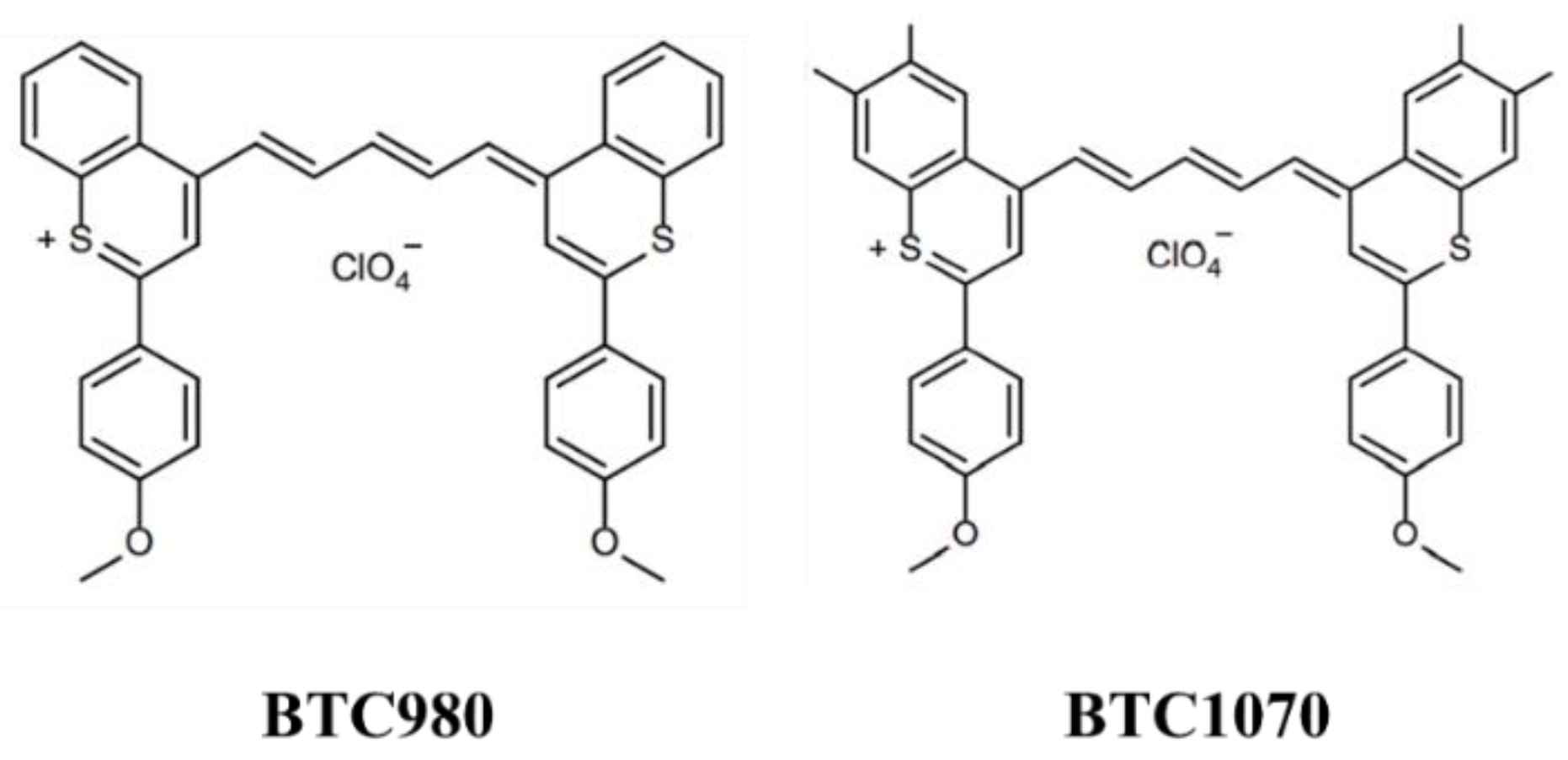
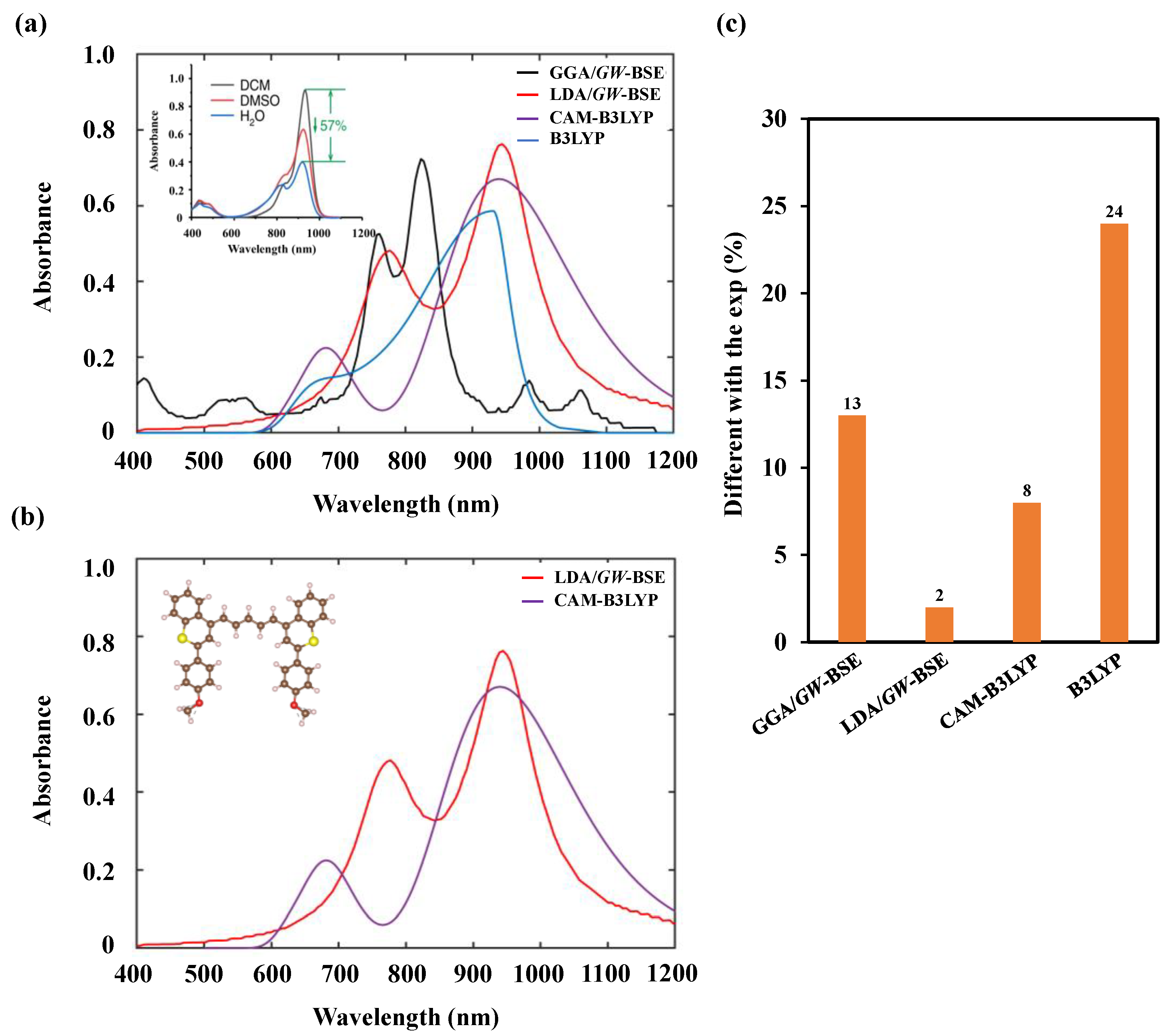
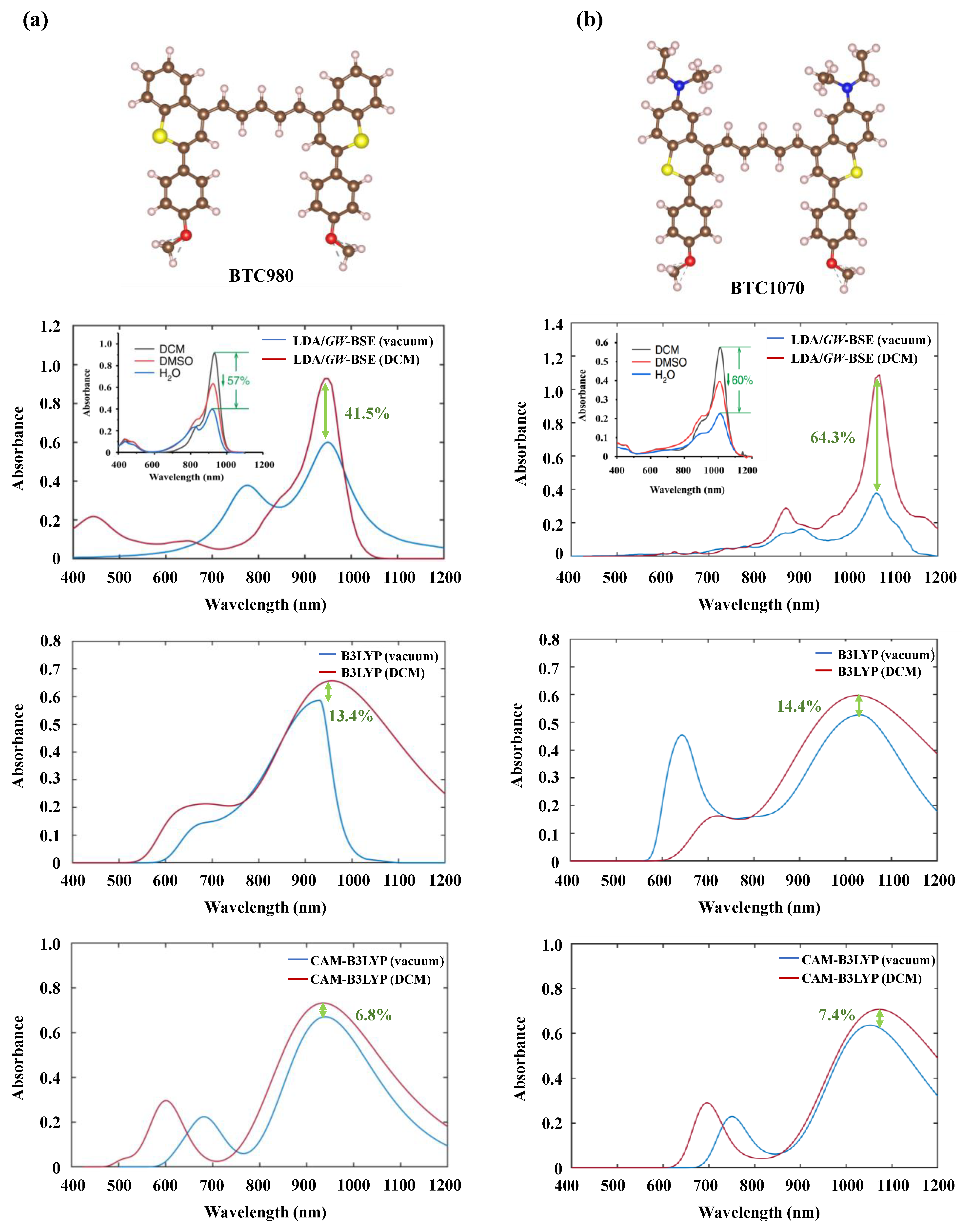
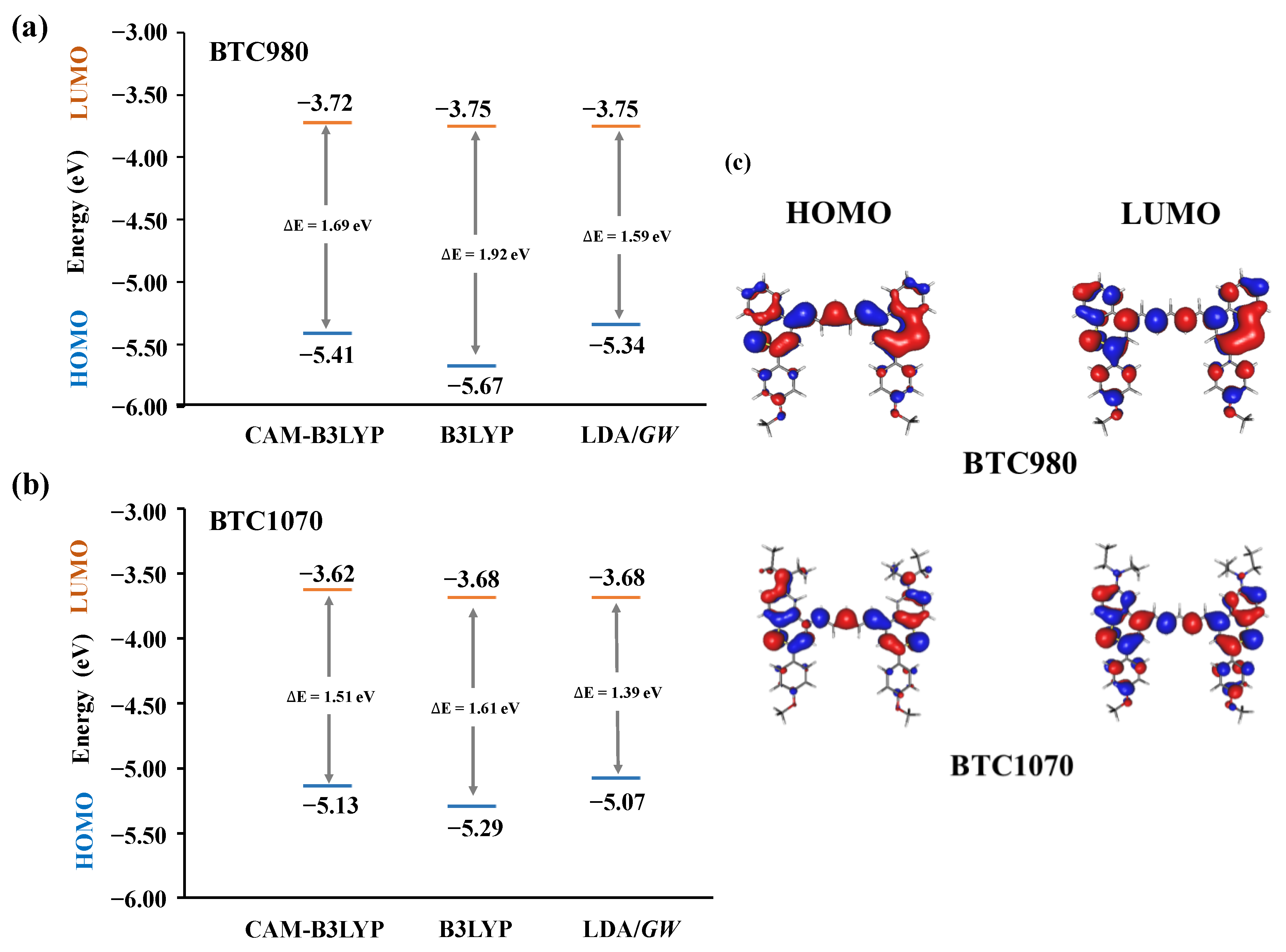
| Dye | (nm) | (nm) | (nm) | (eV) | (eV) | |
|---|---|---|---|---|---|---|
| GW/BSE | 923.4 | 975.1 | 1055 | 1.18 | 1.59 | |
| BTC980 | B3LYP | 921.8 | 931.1 | 990 | 1.25 | 1.92 |
| CAM-B3LYP | 945 | 997 | 1098 | 1.13 | 1.69 | |
| Exp [19] | 932 | 980 | 995 | 1.25 | ||
| GW-BSE | 1014.7 | 1065.4 | 1175 | 1.05 | 1.39 | |
| BTC1070 | B3LYP | 1008.7 | 1016.8 | 1190 | 1.04 | 1.61 |
| CAM-B3LYP | 1019.8 | 1059.2 | 1325.1 | 0.93 | 1.51 | |
| Exp [19] | 1014 | 1064 | 1156 | 1.07 |
Publisher’s Note: MDPI stays neutral with regard to jurisdictional claims in published maps and institutional affiliations. |
© 2021 by the authors. Licensee MDPI, Basel, Switzerland. This article is an open access article distributed under the terms and conditions of the Creative Commons Attribution (CC BY) license (https://creativecommons.org/licenses/by/4.0/).
Share and Cite
Pham, N.N.T.; Han, S.H.; Park, J.S.; Lee, S.G. Optical and Electronic Properties of Organic NIR-II Fluorophores by Time-Dependent Density Functional Theory and Many-Body Perturbation Theory: GW-BSE Approaches. Nanomaterials 2021, 11, 2293. https://doi.org/10.3390/nano11092293
Pham NNT, Han SH, Park JS, Lee SG. Optical and Electronic Properties of Organic NIR-II Fluorophores by Time-Dependent Density Functional Theory and Many-Body Perturbation Theory: GW-BSE Approaches. Nanomaterials. 2021; 11(9):2293. https://doi.org/10.3390/nano11092293
Chicago/Turabian StylePham, Nguyet N. T., Seong Hun Han, Jong S. Park, and Seung Geol Lee. 2021. "Optical and Electronic Properties of Organic NIR-II Fluorophores by Time-Dependent Density Functional Theory and Many-Body Perturbation Theory: GW-BSE Approaches" Nanomaterials 11, no. 9: 2293. https://doi.org/10.3390/nano11092293






